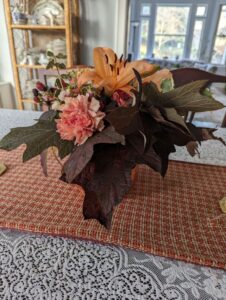 The Lion in Winter is a play by James Goldman that was made into a film in 1968 starring Richard Harris as English King Henry II and, most memorably, Katherine Hepburn as his estranged wife, Eleanor of Aquitaine. The play was set in the twelfth century during the Christmas season, and the titular “lion” was King Henry, aging and attempting to pick a successor from among his sons. In the film, the real “lion”, was in fact, Eleanor, mostly thanks to Hepburn’s performance.
The Lion in Winter is a play by James Goldman that was made into a film in 1968 starring Richard Harris as English King Henry II and, most memorably, Katherine Hepburn as his estranged wife, Eleanor of Aquitaine. The play was set in the twelfth century during the Christmas season, and the titular “lion” was King Henry, aging and attempting to pick a successor from among his sons. In the film, the real “lion”, was in fact, Eleanor, mostly thanks to Hepburn’s performance.
What does The Lion in Winter have to do with gardening? More than you might think. The ideal garden has four seasons of interest, so finding those plants that are “lions in winter”—displaying colorful berries, interesting bark, or compelling shapes—is an important consideration in garden planning.
One of the best “lions in winter” in my garden is Hydrangea quercifolia or oakleaf hydrangea, a vigorous native “lion” that manages to roar in all four seasons by evolving from one lovely stage to another as the days and months progress. Right now, in my garden, the two quercifolias are making a seasonal transition. The giant leaves, which might easily be mistaken for those of an oak tree, have gone through the brilliant crimson stage of early fall and, with the advent of freezing night temperatures, have almost finished the dark maroon or nearly black stage of late fall. The foliage has aged to a sepia shade and each leaf is making a last bow before falling from the branches. Ten days ago, while the leaves were still dark maroon, I clipped several of the branches to use in the Thanksgiving centerpiece. They are still shining indoors, even as the shrubs continue their seasonal journey outside.
Once the leaves have gone, the quercifolias shine in a new way, via their exfoliating bark, which at least one source has described as “corky” in appearance. It is not glossy and flashy, but quietly eloquent—just enough to let you know that the shrub has not gone into complete winter hibernation. Sometimes I clip a few of the bare branches for midwinter arrangements, but mostly I just admire them as I go in and out of the front and back doors.
Hydrangea quercifolia, native to southeastern North America, is deservedly popular among gardeners for its many sterling qualities. Cultivars are available in larger and smaller sizes, with hybridizers working to produce ever-larger flower panicles and configurations that can fit in relatively small landscapes. The wonderful Hydrangeas Plus website lists sixteen separate varieties.
In late spring the shrubs sprout large, pyramid-shaped flower panicles that make their first appearance clothed in creamy white. Composed of scores of small, four-petaled flowers, the panicles age to pale pink, then darker pink, and finally to buff-beige and soft brown. Like other hydrangea flowers, Hydrangea quercifolia flowerheads are suitable for drying, and work best for that application if you clip them just as the petals start to dry. Once floral interest wanes, foliage interest begins, and on it goes.
Oakleaf hydrangeas do their beautiful work with little fuss. Like their hydrangea kin, they prefer a lightly shaded spot with consistent moisture. Drought makes them droop, so mulch to a depth of at least two inches around the base of the plants. I laughed when I saw the phrase “little pruning is usually needed” is the Missouri Botanical Garden’s “Plant Finder”, because quercifolias grow quickly and can reach a height of eight fall tall. They also tend to sucker, because the biological imperative dictates that they form thickets in the wild. All of that is fine if you have the room, but if not, you can counteract the species’ expansive tendencies by pruning right after flowering. I take enough flowerheads to make a few good dried arrangements and compost the rest of the pruned branches. I also watch for suckers at the bases of my two quercifolias and remove them at ground level. By taking both those steps, you can keep yourself and your quercifolias happy.
If your quercifolia has gotten completely out of hand, you can prune anytime, but do so in the knowledge that you will be sacrificing flowers later on.
Even though I have an overall aversion to pruning, I can forgive the quercifolias their vigor because their beauty is so all-encompassing. During the growing season, they have lots of company, but in winter, they are much needed “lions.”
Find the best selection of Hydrangea quercifolia at Hydrangeas Plus, 6543 S. Zimmerman Rd., Aurora, OR 97002; (866) 433-7896 (toll free); www.hydrangeasplus.com.
